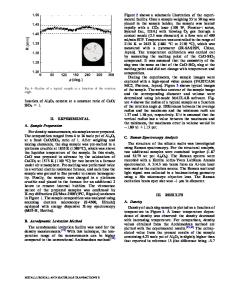Effect of RF power of Al 2 O 3 target on the physical properties of aluminum-doped zinc oxide films
- PDF / 2,306,375 Bytes
- 10 Pages / 595.276 x 790.866 pts Page_size
- 97 Downloads / 349 Views
Effect of RF power of Al2O3 target on the physical properties of aluminum‑doped zinc oxide films Mohamed Fathy Hasaneen1,2 · M. M. Abd El‑Raheem2 · Mahrous R. Ahmed2 Received: 12 July 2020 / Accepted: 24 September 2020 © Springer-Verlag GmbH Germany, part of Springer Nature 2020
Abstract In this report, we investigate the optical and electrical properties of aluminum zinc oxide (AZO) thin films using magnetron sputtering method in preparing the thin films and spectrophotometer to measure the optical characteristics. The X-ray diffraction (XRD) patterns of the films are found to have amorphous structure. The optical band gap E g, refractive index n, electronic 𝛼Ep polarizability, carrier concentration Nc, plasma frequency 𝜔p , electrical resistivity 𝜌s , and sheet resistance Rsh are found to decrease with increasing the RF power of Al2O3 target. The refractive index shows a normal dispersion. Urbach energy Eu and figure of merit are found to increase with increasing the RF power of Al2O3 target. Our results manifest that the change of the RF power of the A l2O3 target can improve the AZO thin films, which is appropriate for solar sell applications. Keywords Sputtering power · Swanepoel’s involved methods · XRD · AZO
1 Introduction One of the most important materials used in several applications is transparent conducting oxide (TCO) because it has a unique performance. TCO is used in the optoelectronic devices [1], the photovoltaic device [2], dissolution of the poisonous organic pollutants in wastewater (photo-catalysis process) [3], optical sensors [4], solar cells [5], devices for saving energy and [6], and touch-screen displays [2]. Indium tin oxide (ITO) is the most common TCO in industrial applications. But indium is a poisonous metal that antagonistic to the environment, expensive and limited resources because it is infrequent earth material [7]. Therefore, the recent studies are looking for a suitable alternative for ITO in TCO. Zinc oxide (ZnO) is widely used in industrial applications such as gas sensors [8], solar cells [9], and photo-diodes [10]. Numerous studies have shown that the physical properties of ZnO can be improved by adding the elements of group III as aluminum (Al) [11].
* Mohamed Fathy Hasaneen [email protected] 1
Physics Department, College of Science, Jouf University, AlJouf, P.O. Box 2014, Sakaka, Saudi Arabia
Physics Department, Faculty of Science, Sohag University, Sohag 82524, Egypt
2
Al is a very effective doping for enhancement of the physical properties of ZnO because it has various advantages such as unique optical and electrical features, non-toxicity material, cheap production, great stability in temperature [7], and available easily [12]. On other hand, the ionic radius of Al3+ ≈ 5.299 × 10–9 cm in aluminum zinc oxide (AZO) films is smaller than Z n2+ ≈ 7.399 × 10–9 cm [11]. Beside, AZO films have a large value of transparency in both visible and near-infrared areas and also low electrical resistance as the bonds between Al and O (1.92 × 10–8), and Zn and
Data Loading...











